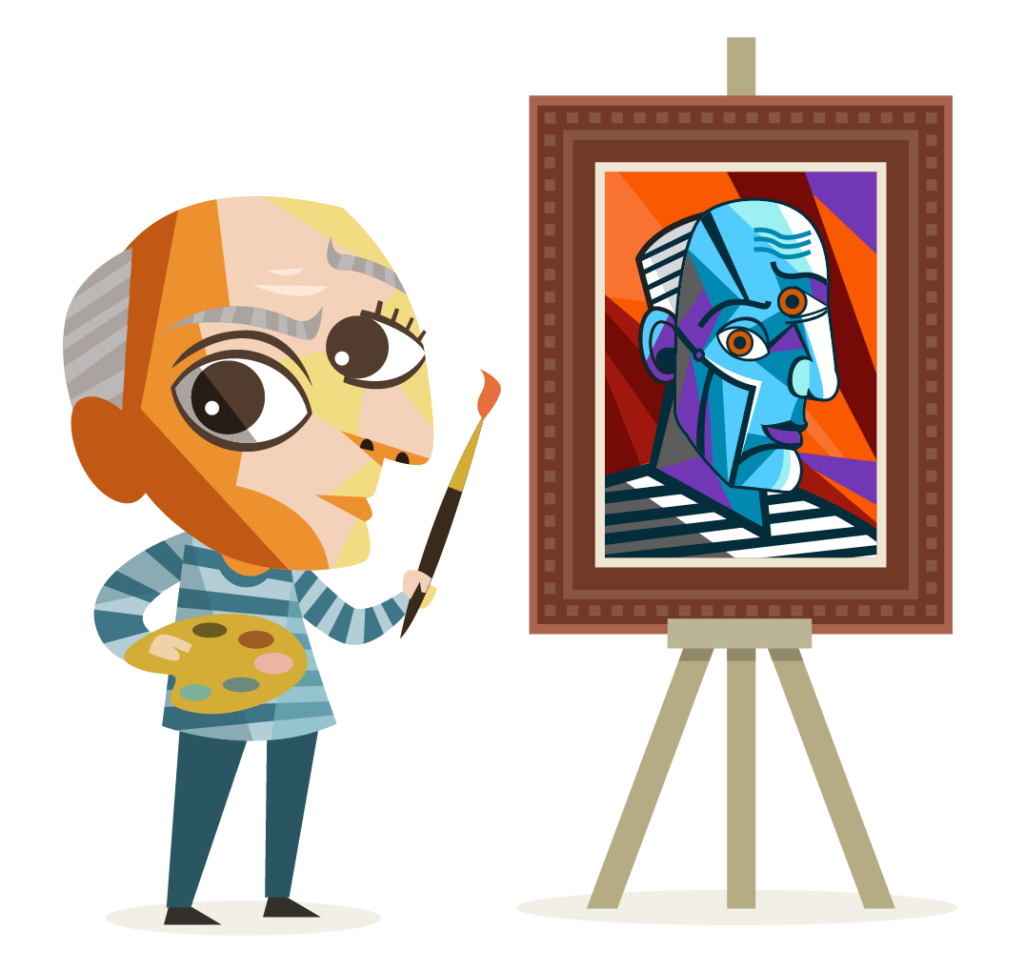
Pablo Picasso - Moderne - 1881-1973
The Birth of a Genius
In the bustling city of Málaga, Spain, on October 25, 1881, a child who would revolutionize the art world was born. His name was Pablo Diego José Francisco de Paula Juan Nepomuceno Crispín Crispiniano María Remedios de la Santísima Trinidad Ruiz Picasso, known simply as Pablo Picasso. From a young age, it was clear that Picasso was no ordinary child. His first word, “pencil,” hinted at his future destiny. His father, José Ruiz Blasco, was a painter and art teacher who recognized his son’s extraordinary talent early on.
José Ruiz Blasco taught at the School of Fine Arts in Málaga, specializing in naturalistic depictions of birds. It was while drawing pigeons, a subject his father often painted, that young Picasso began to demonstrate his remarkable skills. By age 13, Picasso had surpassed his father’s abilities, and José Ruiz Blasco famously vowed never to paint again, acknowledging his son’s superior talent. This early mastery of painting laid the foundation for Picasso’s future explorations in abstract art.
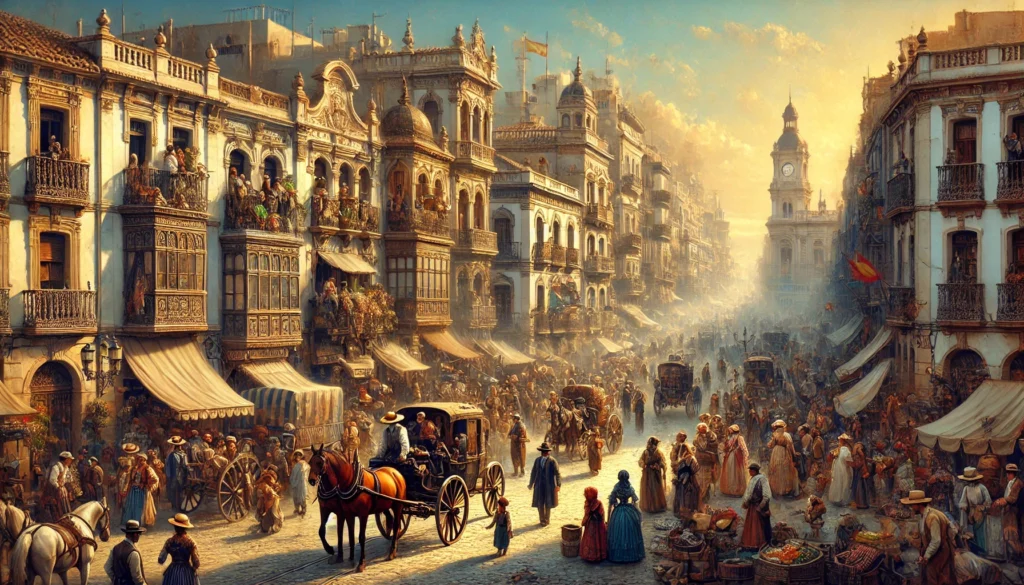
The Early Years and Formal Training
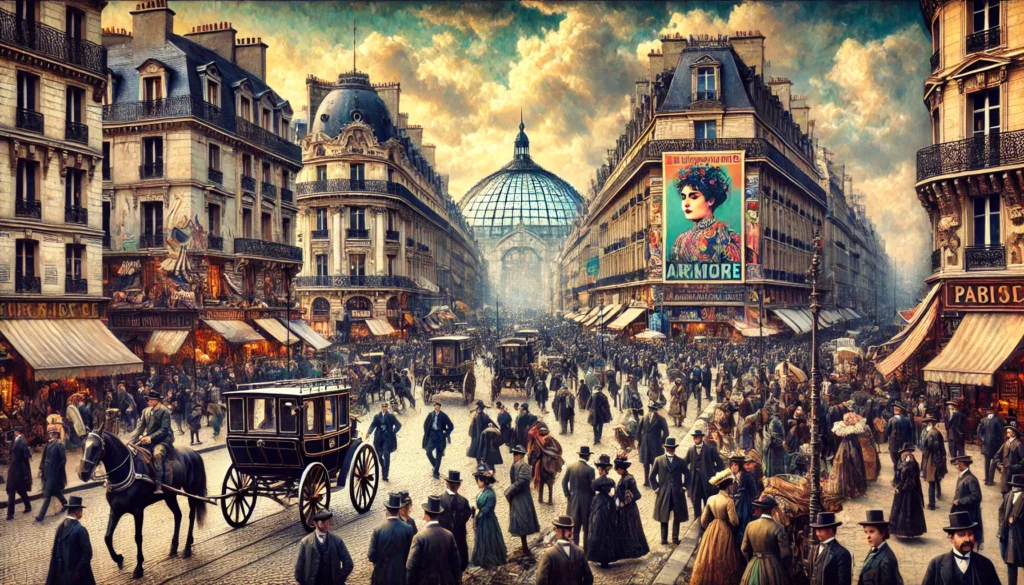
"En 1895, la famille Picasso s'installe à Barcelone. Cette ville dynamique offrait des possibilités plus importantes de développement artistique et d'exposition à diverses galeries d'art, enrichissant ainsi le parcours artistique de Picasso". José Ruiz Blasco obtient l'admission de son fils à la prestigieuse école d'art La Llotja, passant outre la condition d'âge habituelle en raison du talent exceptionnel de Picasso. Le travail de Picasso à La Llotja attire rapidement l'attention. En 1897, il remporte une médaille d'or lors d'une exposition d'art locale à Malaga pour son tableau "Science et charité". Ce succès précoce marque le début de l'ascension de Picasso dans le monde de l'art et ouvre la voie à ses contributions à la peinture et à l'art abstrait.
Plus tard dans l'année, Picasso soumet le même tableau à l'exposition de l'artiste. Exposition générale des beaux-arts à Madridoù il a reçu une mention honorable. Ces récompenses ont apporté à Picasso une reconnaissance précoce et critique et ont validé ses capacités exceptionnelles. Cependant, Picasso trouve l'approche académique traditionnelle restrictive, et son esprit inquiet le pousse à chercher de nouveaux horizons, influençant finalement la scène artistique en ligne.
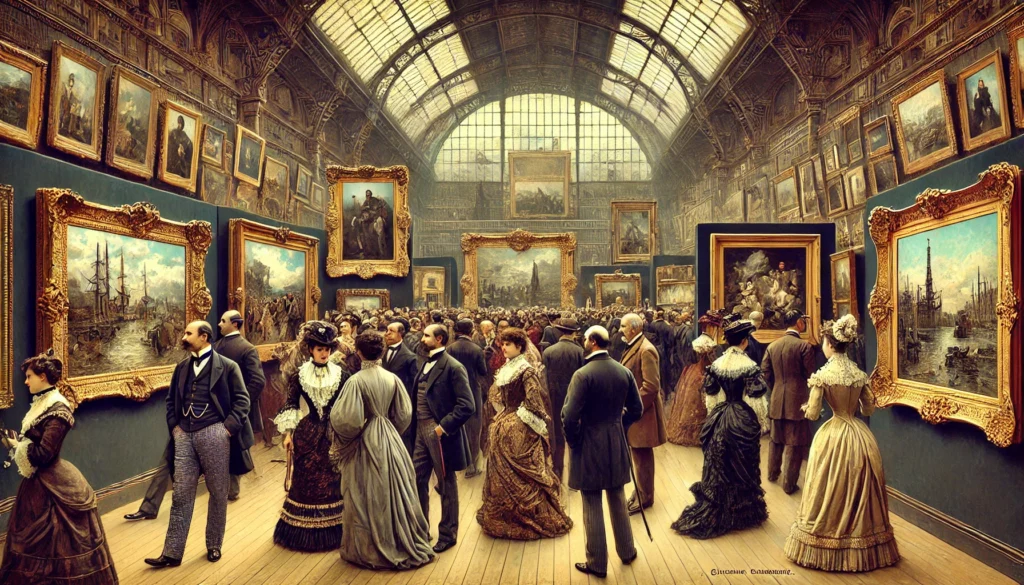
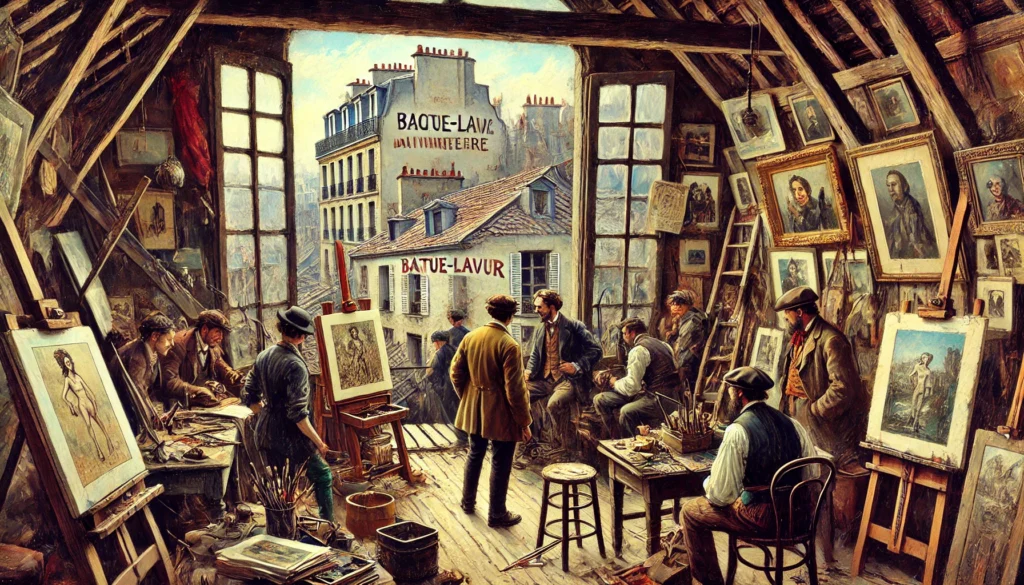
A Journey to Paris
In 1895, the Picasso family moved to Barcelona. This vibrant city offered more significant opportunities for artistic development and exposure to various art galleries. José Ruiz Blasco secured his son’s admission to the prestigious La Llotja art school, bypassing the usual age requirement due to Picasso’s exceptional talent. Picasso’s work at La Llotja quickly garnered attention. In 1897, he won a gold medal at a local art exhibition in Málaga for his painting “Science and Charity.” This early success marked the beginning of Picasso’s rise in the art world and set the stage for his contributions to painting and abstract art.
Later that year, Picasso submitted the same painting to the General Exhibition of Fine Arts in Madrid, where it received an honorable mention. These accolades provided Picasso with critical early recognition and validated his exceptional abilities. However, Picasso found the traditional academic approach restrictive, and his restless spirit soon led him to seek new horizons, eventually influencing the online art scene.
The Blue and Rose Periods
Picasso’s early years in Paris were marked by the Blue Period (1901-1904), characterized by somber tones of blue and blue-green. This period reflected Picasso’s melancholy mood, influenced by the suicide of his close friend, Carlos Casagemas. The themes of poverty, despair, and isolation permeated his work, capturing the struggles of the human condition through his evocative paintings.
Around 1904, Picasso’s palette shifted to warmer tones, heralding the onset of the Rose Period (1904-1906). This period featured more cheerful and vibrant subjects, such as circus performers, harlequins, and acrobats. The change in style mirrored Picasso’s more optimistic outlook, influenced by his new romantic relationship with Fernande Olivier, a French artist’s model, and his muse during this time. These distinct periods of Picasso’s work are celebrated in art galleries and continue to influence contemporary abstract art, available for art lovers to explore and buy online.
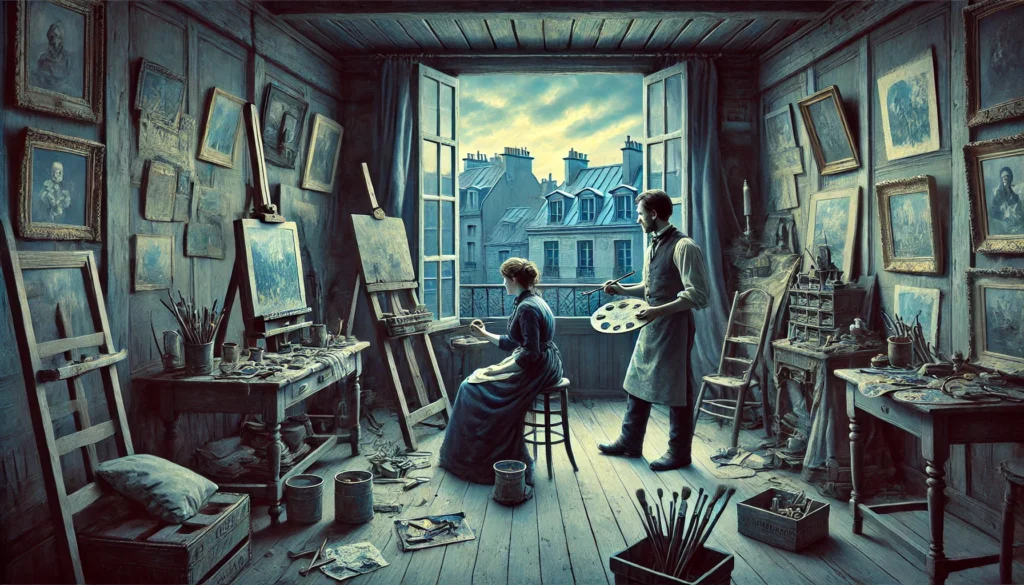
Key Figures and Influences
During Picasso’s early years in Paris, he formed essential friendships and connections with several notable artists who would shape his career and the broader modern art movement.
Henri Matisse
Henri Matisse et Picasso ont entretenu une relation dynamique marquée par le respect mutuel et la rivalité. Ils ont été présentés par Gertrude Stein, une collectionneuse d'art et écrivaine influente. Malgré leur nature compétitive, ils ont échangé des idées et des œuvres d'art, se défiant et s'inspirant l'un l'autre. L'utilisation de la couleur et de la forme par Matisse a considérablement influencé Picasso, et leur dialogue artistique a joué un rôle crucial dans le développement de l'art moderne. Leurs échanges ont souvent eu lieu dans diverses galeries d'art et dans des musées. art exhibitions, where their works were frequently showcased side by side, influencing each other’s techniques and styles.
Georges Braque
Georges Braque was Picasso’s close collaborator in developing Cubism. Their partnership was so synergistic that their works from this period are often indistinguishable. Together, they deconstructed objects into geometric shapes and depicted them from multiple perspectives, revolutionizing how art represented reality. This collaboration lasted from 1908 to 1914 and powerfully influenced abstract art. Their joint exhibitions in art galleries across Paris helped cement Cubism as a revolutionary movement, attracting art lovers to explore and buy art online and in person.
Amedeo Modigliani
Amedeo ModiglianiPeintre et sculpteur italien, il faisait partie de la communauté parisienne de l'avant-garde et était en relation avec Picasso. Ils fréquentaient tous deux les mêmes cafés et galeries d'art à Montmartre et Montparnasse. Bien que leurs styles artistiques soient différents - Modigliani est connu pour ses portraits allongés et ses nus - ils partagent un cercle familier d'amis et de mécènes, influençant leur approche mutuelle de l'art. Leur admiration mutuelle s'est souvent exprimée par des critiques et des discussions dans des cadres informels, enrichissant aujourd'hui la communauté artistique en ligne.
Joan Miró
Joan Miró, a Catalan painter and sculptor, was influenced by Picasso and the broader surrealist movement. Although their direct interactions were limited, Miró was inspired by Picasso’s innovations and his ability to break away from traditional art forms. Picasso’s move to embrace different styles and media encouraged Miró to explore his surrealistic expressions, contributing significantly to the digital art movement that allows enthusiasts to purchase art online.
Salvador Dalí
Salvador Dalí admire beaucoup Picasso. Dalí rendit visite à Picasso à Paris en 1926 et le considéra comme un mentor. Les premières œuvres cubistes de Picasso ont considérablement influencé le style surréaliste de Dalí. Malgré des désaccords politiques ultérieurs, Dalí considérait Picasso comme une figure monumentale du monde de l'art. Leurs interactions ont souvent eu lieu lors d'expositions d'art et de rassemblements d'artistes surréalistes, où ils ont échangé des idées qui ont ensuite façonné leurs chefs-d'œuvre respectifs.
Kees van Dongen
Kees van Dongen, a Dutch-French painter, was part of the Fauvist movement and interacted with Picasso through the Parisian art circles. Known for his bright colors and bold brushwork, van Dongen influenced Picasso’s exploration of color. They both exhibited at the Salon d’Automne and shared mutual friends within the avant-garde community, enhancing the landscape of digital art exhibitions today and influencing the modern approach to buying art online.
Fernand Léger
Fernand Léger, a French painter, developed his form of Cubism after being influenced by Picasso and Braque. Léger and Picasso had a professional relationship, sharing ideas about form and abstraction. Léger’s focus on the mechanical aspects of modern life provided a different angle to the Cubist movement that intrigued Picasso, leaving a legacy in traditional and online art spaces, where their works continue inspiring new generations of artists and collectors.
Vincent van Gogh
Bien que Vincent van Gogh et Picasso ne se sont jamais rencontrés, as van Gogh died in 1890 and Picasso moved to Paris a decade later, van Gogh’s work significantly impacted Picasso. Van Gogh’s bold use of color and expressive brushwork left a lasting impression on Picasso. Exhibitions of van Gogh’s work in Paris, such as the 1901 retrospective organized by art dealer Ambroise Vollard, allowed Picasso to study van Gogh’s paintings closely. Van Gogh’s approach to capturing deep emotion and movement through color influenced Picasso’s Blue and Rose periods and his subsequent explorations in abstract and modern art.
Impact and Legacy
The interactions and influences of these contemporaries created a rich, collaborative environment in early 20th-century Paris, where artists exchanged ideas and pushed the boundaries of traditional art. Picasso’s relationships with these prodigies were integral to his development and the evolution of modern art. His friendships and rivalries fostered a creative synergy contributing to his dynamic and influential career. This legacy inspires contemporary art exhibitions and platforms where enthusiasts can purchase art online.
The Birth of Cubism
Cubism emerged as a response to the limitations of traditional perspective and representation. Picasso and Braque sought to capture the essence of their subjects by portraying them from various angles. This groundbreaking approach challenged conventional notions of art. It paved the way for modernist movements, significantly influencing abstract art and modern art.
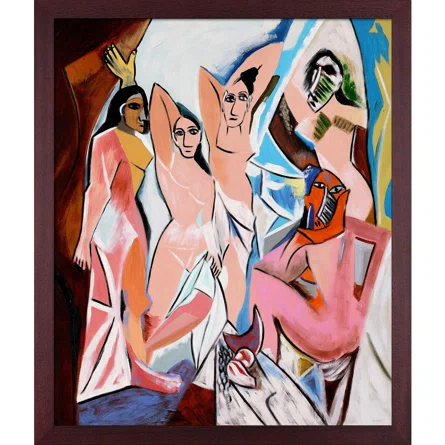
One of Picasso’s most famous works from this period is “Les Demoiselles d’Avignon” (1907), a radical departure from traditional composition and perspective. The painting depicts five female figures with fragmented and distorted forms, influenced by African art and Iberian sculpture. This work marked the beginning of Picasso’s exploration of Cubism and set the stage for his subsequent innovations. Today, Picasso’s Cubist works are celebrated in art galleries and art exhibitions worldwide and continue to inspire both traditional and digital art platforms, where enthusiasts can purchase art online.
Collaborations with Erik Satie
During this vibrant period in Paris, Picasso also forged significant collaborative relationships with other avant-garde artists, including the composer Erik Satie. Their collaborations exemplified the interdisciplinary spirit of the avant-garde movement, blending music, visual art, and performance.
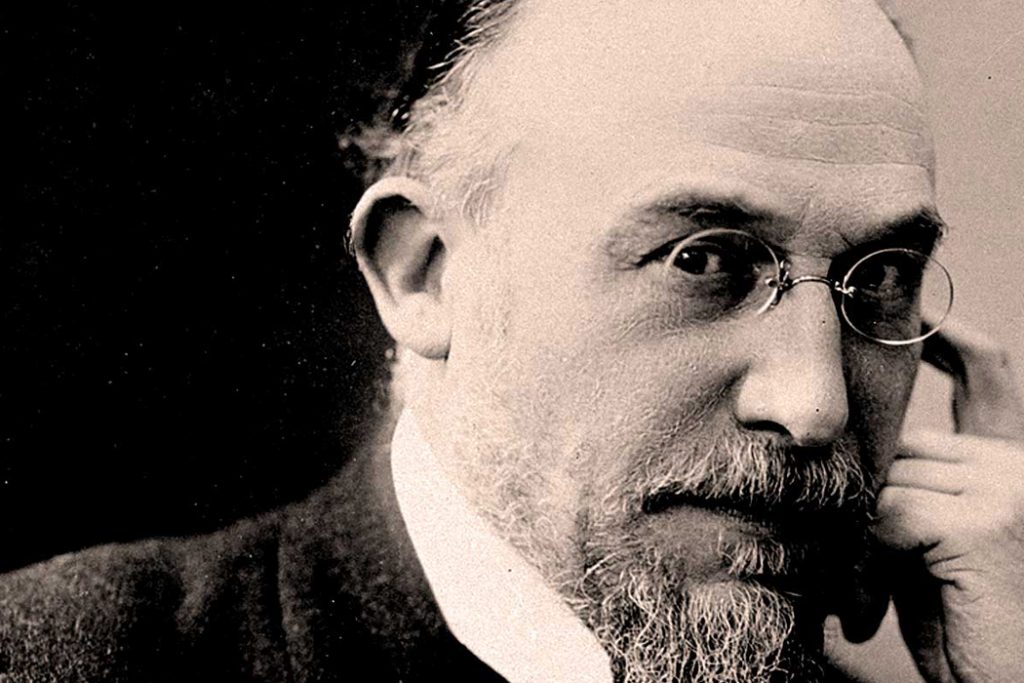
**1. Parade (1917)**:
– **Overview**: “Parade” was a groundbreaking ballet with music composed by Erik Satie, a scenario by Jean Cocteau, and set and costume designs by Picasso. It was produced by Sergei Diaghilev for the Ballets Russes and premiered in Paris in 1917.
– **Picasso’s Contribution**: Picasso’s involvement was crucial to the visual aspect of the ballet. He designed the sets and costumes, introducing elements of Cubism into the stage design. The costumes were especially notable for their abstract, geometric forms that challenged traditional ballet aesthetics.
– **Satie’s Music**: Satie composed a score incorporating unconventional sounds for the time, such as typewriters, sirens, and airplane propellers, aligning with the project’s modernist and avant-garde nature.
– **Reception**: The premiere of “Parade” was met with mixed reviews and controversy. Some audiences were shocked by the innovative and unconventional elements, while others appreciated the fresh, modern approach. Satie and Picasso’s collaboration in “Parade” is often seen as a landmark in integrating visual art and performance.
**2. Mercure (1924)**:
– **Overview**: “Mercure” was another ballet featuring a collaboration between Picasso and Satie, with choreography by Léonide Massine.
– **Picasso’s Role**: Picasso once again designed the sets and costumes for the ballet. His designs for “Mercure” continued to explore abstract and Cubist themes, contributing to the modernist aesthetic of the production.
– **Satie’s Music**: Satie’s composition for “Mercure” was in keeping with his style, providing a unique and innovative musical backdrop for the ballet.
Personal Challenges and Triumphs
Despite his professional success, Picasso’s personal life was marked by challenges and tragedies. The death of Carlos Casagemas deeply affected him, leading to the reflective and melancholy Blue Period. While passionate, his relationship with Fernande Olivier was tumultuous and ended in 1912.
Picasso’s relentless pursuit of artistic innovation often came at the cost of personal stability. His intense focus on his work sometimes strained his relationships and led to periods of isolation. However, his resilience and determination to push the boundaries of art kept him at the forefront of the avant-garde movement.
In the mid-1930s, Pablo Picasso met a woman who would become one of the most essential muses and influences in his life and work: Dora Maar. Their relationship was marked by intense passion, creative collaboration, and emotional turbulence.
**1. Meeting Dora Maar**:
– **Encounter**: Picasso and Dora Maar met in 1936 at the Café des Deux Magots in Paris. The poet Paul Éluard facilitated their introduction.
First Impressions: Picasso was immediately struck by Maar’s beauty, intelligence, and enigmatic presence. Dora Maar was a stunning woman and an accomplished artist and photographer.
**2. Dora Maar**:
– **Background**: Dora Maar, Born Henriette Théodora Markovitch in 1907, was a French photographer and painter of Croatian descent. She had a successful commercial photography career and was involved in the Surrealist movement.
– **Artistic Talents**: Maar’s work encompassed a range of styles, from surrealist photography to abstract painting. Her artistic talents and intellectual prowess made her a compelling figure in the Parisian avant-garde scene.
**3. Relationship and collaboration**:
– **Creative Synergy**: Dora Maar’s influence on Picasso extended beyond her role as a muse. She was actively involved in his creative process, often photographing his works and documenting their progression.
– **Guernica**: One of the most significant collaborations between Picasso and Maar was the creation of the monumental painting “Guernica” (1937). Maar documented the various stages of this masterpiece, providing invaluable visual records of Picasso’s
Process. Her influence can be seen in the work’s emotional intensity and surrealistic elements.
**4. Portraits of Dora Maar**:
– **Iconic Muse**: Maar became the subject of numerous portraits by Picasso, often depicted in a highly stylized and expressive manner. These portraits are characterized by their emotional depth and dramatic use of form and color.
– **Emotional Intensity**: The portraits of Dora Maar reveal the complexity of their relationship. Picasso captured her in various states, from serene and contemplative to frantic and fragmented. Some of the most famous portraits include “Weeping Woman” (1937) and “Dora Maar au Chat” (1941).
**5. Relationship Dynamics**:
Passion and Conflict: Picasso and Maar’s relationship was marked by intense passion and frequent conflicts. Both highly creative individuals often clashed, leading to volatile interactions.
– **Psychological Impact**: The emotional strain of their relationship took a toll on Maar. Picasso’s domineering personality and infidelities exacerbated the tension, leading to periods of profound distress for Maar.
**6. World War II**:
– **Impact of War**: The outbreak of World War II and the German occupation of Paris further strained their relationship. Picasso and Maar remained in Paris during the war, navigating the challenges and dangers of the time.
**7. Separation**:
** End of Affair **: By the early 1940s, Picasso’s relationship with Maar deteriorated. In 1943, Picasso met and began a relationship with Françoise Gilot. This young painter marked the end of his romantic involvement with Maar.
– **Aftermath**: The end of their relationship profoundly affected Maar. She suffered a mental breakdown and sought treatment from psychiatrist Jacques Lacan. After their separation, Maar withdrew from the public eye and focused on her art and spirituality.
The Spanish Civil War, which occurred from 1936 to 1939, was a brutal conflict that deeply affected Picasso. One of the most significant events during this period was the bombing of the Basque town of Guernica by German and Italian forces allied with Franco’s Nationalists.
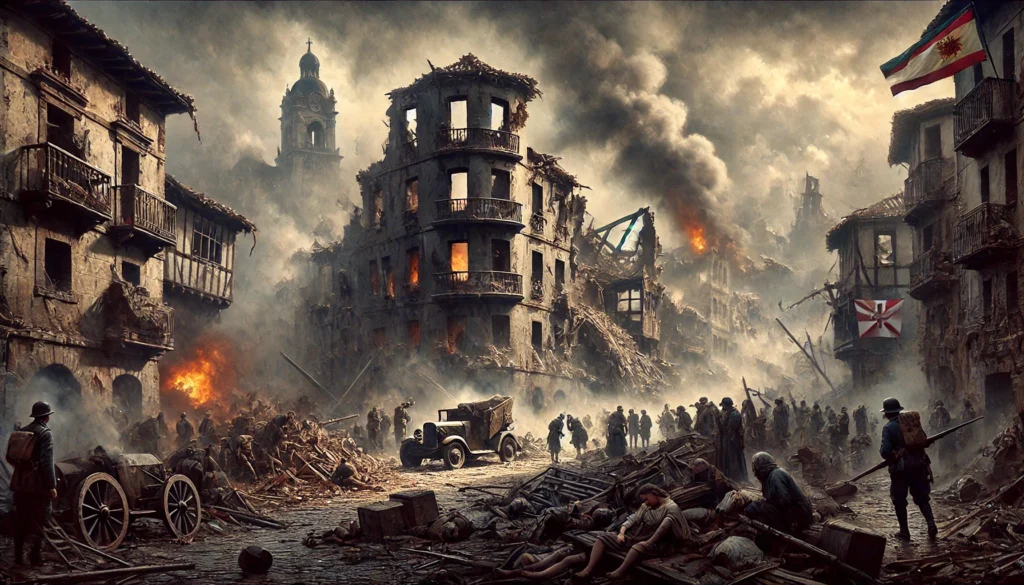
**1. The Bombing of Guernica**:
– **Date**: On April 26, 1937, the town of Guernica was bombed, resulting in the deaths of between 200 and 800 people.
– **Impact**: The bombing was one of the first aerial bombings of a civilian population and became a symbol of the horrors of war.
**2. Creation of “Guernica”**:
– **Commission**: The Spanish Republican government commissioned Picasso to create a large mural for the Spanish Pavilion at the 1937 Paris International Exposition.
– **Inspiration**: Moved by the news of the bombing, Picasso began work on “Guernica” in May 1937.
– **Completion**: The mural, approximately 3.5 meters tall and 7.8 meters wide, was completed in about a month and displayed in June 1937.
**3. The painting**:
– **Imagery**: “Guernica” is characterized by its stark black, white, and grey tones, depicting the chaos, suffering, and destruction of the bombing.
– **Symbolism**: The painting includes tragic figures, a bull, a horse, and other symbolic elements, conveying the tragedy of war.
– **Legacy**: “Guernica” became an iconic anti-war symbol and one of Picasso’s most famous works.
Françoise Gilot and Later Relationships
Françoise Gilot was another significant figure in Picasso’s life. Their relationship began in 1943 and was marked by personal and artistic collaboration. However, her accounts provide a deeper insight into Picasso’s personality and behavior, revealing a darker side that aligns with many symptoms of psychopathy.
Gilot describes Picasso in ways that align with many symptoms of psychopathy:
- A total lack of empathy and genuine affection.
- A disregard for remorse.
- A tendency to justify his hurtful actions.
His relationships were characterized by a desire to seduce as a means of exerting power, a lifestyle of manipulation and deceit, and a recurring pattern of idealizing, devaluing, and discarding romantic partners. Picasso’s behavior exhibited a strong need for control, an unyielding narcissism, and a drive to cause harm to the women in his life. By examining Gilot’s autobiographical accounts alongside psychological theories on psychopathy and narcissistic control, we can better understand the pathological aspects of Picasso’s behavior.
**1. Françoise Gilot**:
– **Background**: Françoise Gilot, born in 1921, was a young painter when she met Picasso. She was independent and strong-willed, qualities that attracted Picasso.
– **Relationship**: Gilot and Picasso had a turbulent relationship that lasted about ten years. They had two children together, Claude and Paloma.
– **End of Relationship**: Unlike many of Picasso’s previous partners, Gilot left him of her own accord in 1953, citing his infidelities and controlling behavior.
**2. Jacqueline Roque**:
– **Meeting Jacqueline**: Picasso met Jacqueline Roque in 1952 at the Madoura Pottery workshop in Vallauris, France.
– **Marriage**: They married in 1961, and Jacqueline became Picasso’s muse and companion until his death.
– **Influence**: Jacqueline was depicted in numerous artworks by Picasso, and she played a significant role in his later life.
Artistic Legacy and Later Life
Picasso’s later years were marked by continued artistic innovation and exploration. He remained prolific, producing works across various media, including painting, sculpture, and ceramics.
**1. La Colombe**:
– **Symbol**: Picasso’s “La Colombe” (The Dove) became a symbol of peace, mainly after one version was used as the emblem for the 1949 World Peace Congress in Paris.
– **Legacy**: The dove remains one of the most enduring symbols associated with Picasso.
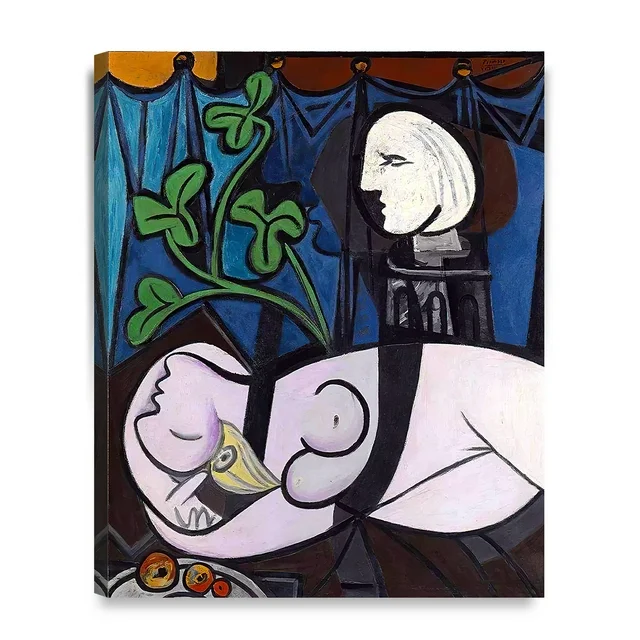
**2. Children**:
– **Claude Picasso**: Born in 1947, Claude was involved in managing Picasso’s estate and artistic legacy.
– **Paloma Picasso**: Born in 1949, Paloma became a renowned fashion designer and businesswoman.
Visits and Encounters
Throughout his life, Picasso interacted with many influential figures from various fields. One notable encounter was with American actor Gary Cooper in the 1950s, reflecting Picasso’s wide-reaching influence and the intersection of art and popular culture.
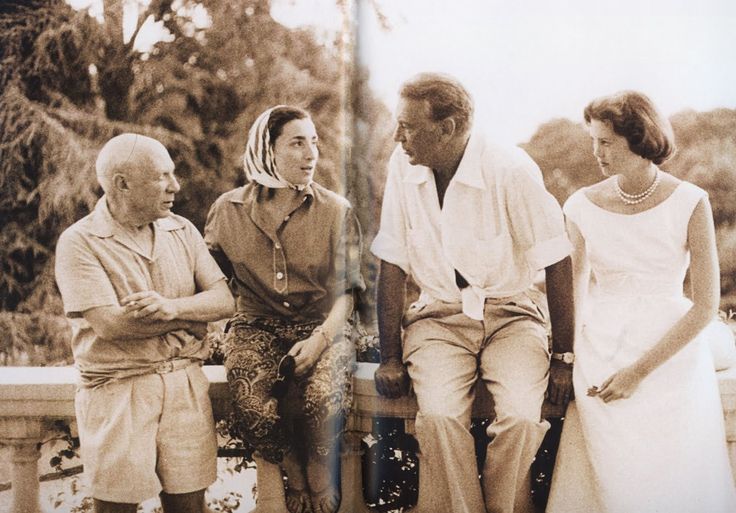
Death and Legacy
Pablo Picasso died in Mougins, France, on April 8, 1973, at 91. Although his death marked the end of an era, his influence continues to resonate through his vast body of work and the many artists he inspired.
Pablo Picasso’s life and work are deeply intertwined with the significant historical and cultural events of the 20th century. From his powerful anti-war statement in “Guernica” to his complex personal relationships and enduring artistic legacy, Picasso’s story is one of constant innovation, emotional depth, and profound impact on art. His relationships with women like Dora Maar, Françoise Gilot, and Jacqueline Roque, his influence on his children, his symbolic works like “La Colombe,” and his encounters with figures like Gary Cooper all contribute to the rich tapestry of his life. His death marked the end of an era, but his influence continues to resonate through his vast body of work and the many artists he inspired.
Most expensive pieces ever sold by Pablo Picasso:
- Les Femmes d’Alger (“Version O”) (1955)
- Sold for: $179.4 million
- Auction: Christie’s, New York, May 2015
- This painting set a world record for the highest price ever paid for a painting at auction.
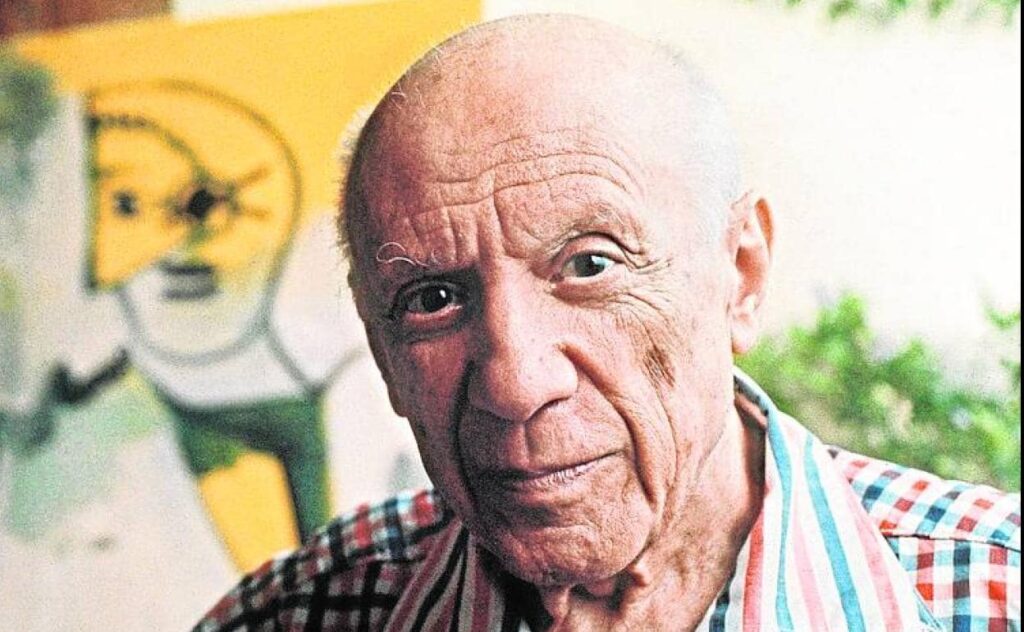
Sources d'information
- Tate : Picasso et Matisse
https://tate.org.uk/art/artists/henri-matisse-1600/picasso-and-matisse - Musée d'art moderne : Georges Braque et Picasso
https://moma.org/artists/712 - Metropolitan Museum of Art : Amedeo Modigliani
https://metmuseum.org/toah/hd/modi/hd_modi.htm - Fondation Joan Miró : Picasso et Miró
https://fmirobcn.org/en/ - Fondation Salvador Dalí : Dalí et Picasso
https://salvador-dali.org/en/ - Van Dongen et les Fauves
https://kunsthaus.ch/en/exhibitions/van-dongen/ - Centre Pompidou : Fernand Léger
https://centrepompidou.fr/en/ - Musée Van Gogh
https://vangoghmuseum.nl/en/stories/on-the-trail-of-picasso
